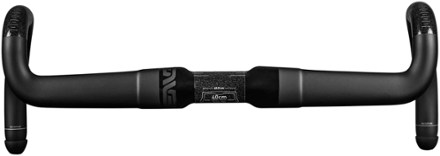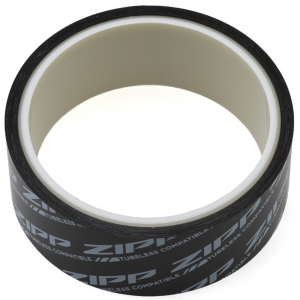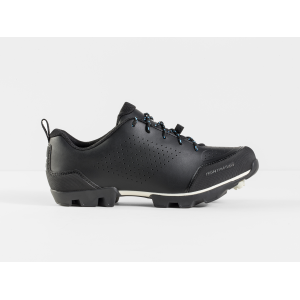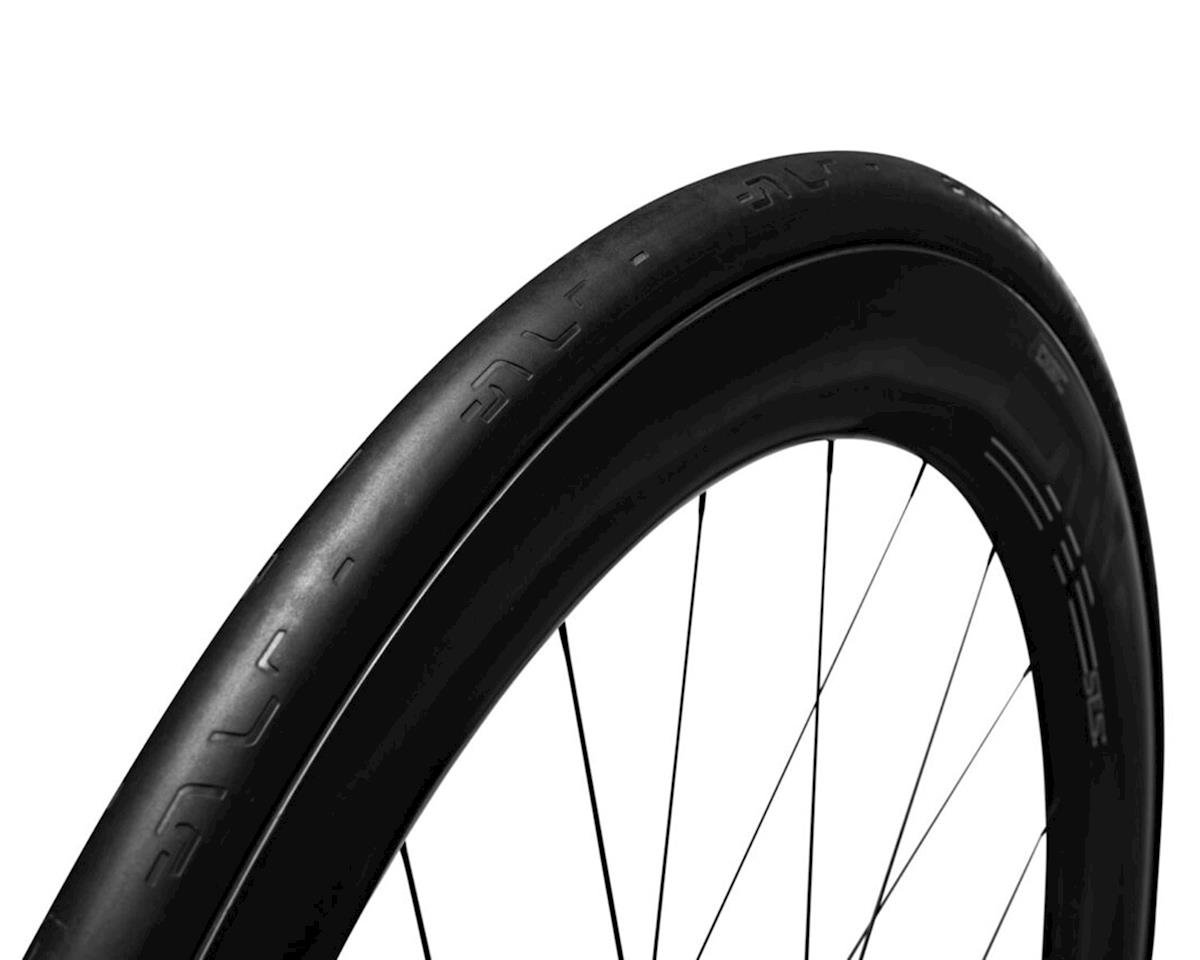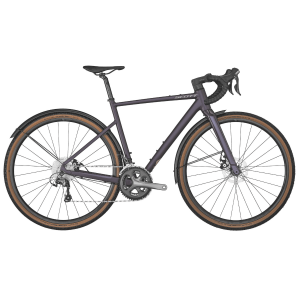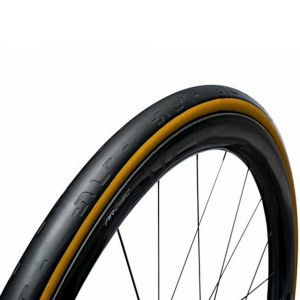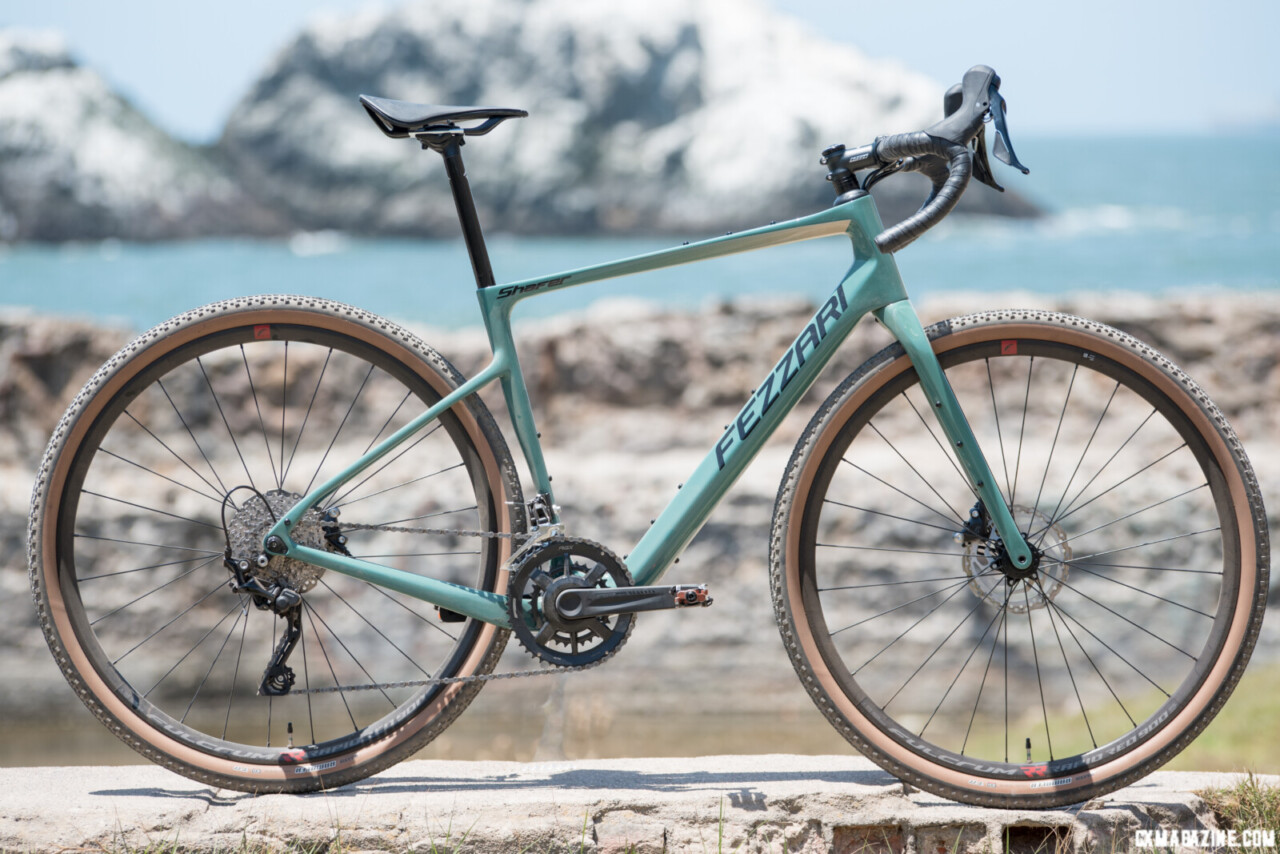
Fezzari Shafer gravel bike. © C.Lee/ Cyclocross Magazine
In 2017 cyclocross in the United States led to a new “off-season” phenomenon of long off-road races and events where the ‘cross bike was the weapon of choice. While this was going on for years before as a somewhat underground scene, that year it seemed to reach a critical mass. As the sport evolved, bike companies began to introduce bikes that were more specific to the long events combining qualities of road racing bikes with the terrain capability of cyclocross bikes.
That year, Fezzari, a direct-to-consumer mountain bike brand, introduced the Shafer gravel bike. Direct-to-consumer bikes were still a novel concept at the time, though Canyon Bicycles popularized the method of sales. Fezzari started with the direct-to-rider sales model a decade before Canyon entered the U.S. market. To gain rider confidence, Fezzari has a 30-day Love it or Return it policy and a lifetime warranty, as well as a crash replacement policy.
What’s in a Name?
Fezzari is a dozen years old and the name is known to some bike enthusiasts, but I’ve always wondered about the origin of the name. It is best explained by the founder himself.
Fork in the Gravel Road
Broadly, the gravel bike is a drop bar off-road capable bike. Unlike cyclocross bikes, gravel bikes have adapted to long-distance events with geometry that offers more stable handling and hopefully more comfort. Increased trail and lower bottom bracket height are key geometry parameters to achieve this.
There are generally two categories of gravel bikes: gravel race versus gravel adventure. The former could be considered a road bike with wide tire clearance. The latter is touring-bike-meets-mountain-bike. Of course, categories blend with no distinct demarcation. The Fezzari Shafer is definitely on the adventure side of the gravel category.
The original Fezzari Shafer was exactly the cyclocross-meets-road bike design. The maximum tire clearance on the original Shafer was 40mm. The newer Fezzari Shafer ridden and reviewed here is a completely different bike with 50mm tire clearance and a long, slack front end.
In the second half of 2021, Fezzari introduced the new carbon Shafer and an aluminum version shortly thereafter. Although the bikes share the same name, the carbon and aluminum versions have slightly different geometry. Our review is for the carbon Shafer. Fezzari sent a Sage Green Comp GRX model for review.
Fezzari Shafer’s Front End Geometry
The hot topic in bike geometry varies from period to period. A decade ago it was bottom bracket drop, then tire clearance, and now head tube angle. There is a lot more to it than that. If the head tube angle is less steep in relation to the ground, that puts the wheel further in front of the bike and increases trail. If the fork offset, or rake, increases, it puts the wheel even further out front but reduces the trail figure. Trail affects steering feel, shorter to a point feels more responsive, and longer gives a more stable feel when going faster. Putting the wheel further in front of the bike extends the front center, a measurement from the crank spindle to the front axle. A longer front center puts the rider’s weight further behind the front wheel. This makes the bike feel more balanced under conditions where the rider’s weight comes forward, such as when pointing downhill or if braking hard. It has the opposite effect when pointing up.
This description is simplified quite a bit, but it roughly explains why the slacker front end is desirable for steep downhill technical terrain. All that said, the Fezzari Shafer has a 68.9-degree head tube angle and a 50mm fork offset across the size range, calculating 85mm of trail with a 45mm tire on (or 80mm of mechanical trail). There is a difference between horizontal trail and mechanical trail that is well explained here.
For comparison of trail figures in millimeters, most road bikes are in the 60s, cyclocross race bikes vary from the high 60s into the 70s, and gravel bikes are typically in the mid to upper 70s. The two bikes we recently reviewed with higher trail figures are the Evil Chamois Hagar and the Nukeproof Digger. The trail figure for the former is 95.8mm, and the latter is 86.2mm. That puts Fezzari Shafer on par with the Nukeproof Digger.
Fezzari Shafer Carbon Frame
The Fezzari Shafer is a monoformed carbon monocoque made in Taiwan. Monoform refers to the entire frame made in a single mold without the need to bond separate sections. It is more common to find carbon bicycles with two monocoque sections bonded together. Fezzari calls its carbon frame mold technology “Clean Cast”. This refers to using an expanded polystyrene form (mandrel) in the carbon mold instead of an inflatable bladder. The form expands when curing the frame, then shrinks for easy removal. The theoretical advantage of this method is less void in the resin and better compaction of the fibers. This method is not unique to Fezzari.
The frameset is sent directly from Fezzari’s manufacturing partner in Taiwan to Utah for made-to-order bike assembly.
Our review bike is a size M with a 55.9cm effective top tube measurement and a 391.5mm reach. The sloping top tube has a very flat, broad top with 3 bolts to support and hold a top tube bag. The head tube is 158mm tall contributing to the 585.4mm stack height. The head tube is also massive enough to allow the control lines to run through. The Shafer uses the FSA SRS (Simple Routing System), similar to the Trek Boone Control Freak system, where all control lines enter the top front of the head tube. The stem on the Shafer is much shorter than the Boone in the review, so the control lines have tighter bends on this Shafer.
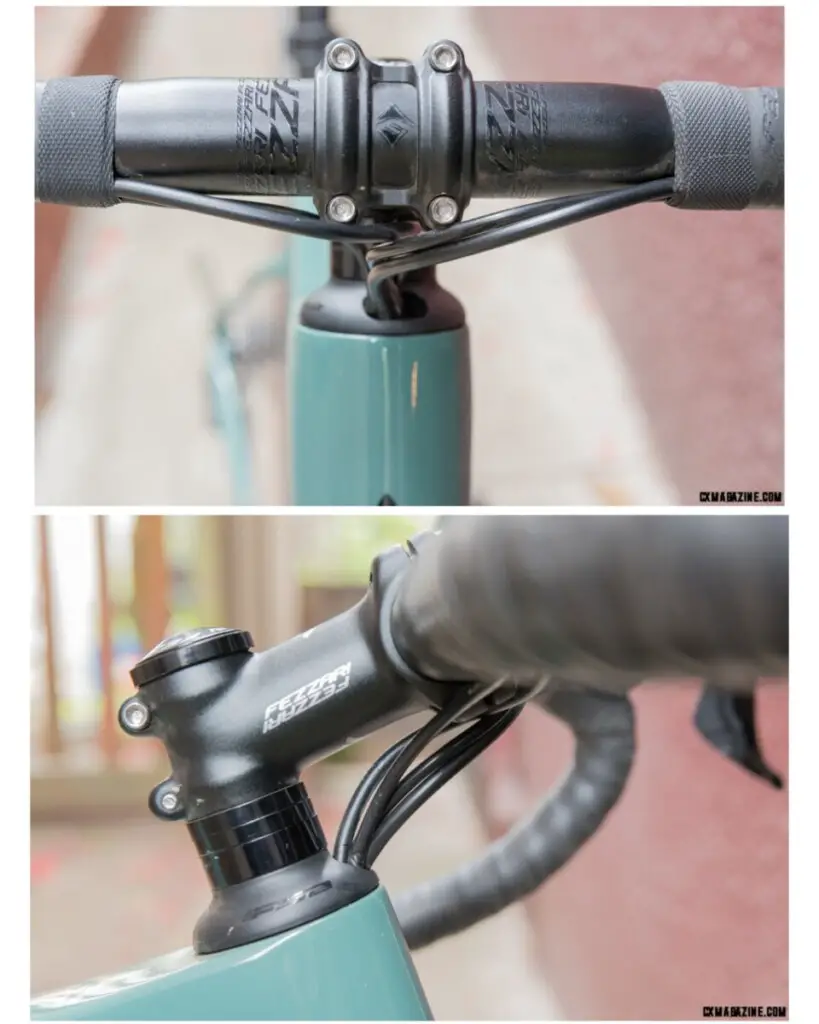
FSA SRS simple cable routing creates tight bends even with the stem flipped up. © C.Lee/ Cyclocross Magazine
The down tube is massive, has an octagonal cross section, and curves towards the bottom bracket similar to a modern mountain bike. The bottom bracket is an old-school 68mm wide with BSA threads. Somehow Fezzari manages to squeeze a 50mm tire clearance even with 43cm chainstays that are 1 cm shorter than the old Shafer. The bottom bracket drop is 7.7cm, on par with a lot of current gravel-specific bikes. The Shafer has the SRAM Universal Derailleur Hanger (UDH), so it is compatible with the new SRAM Eagle Transmission.
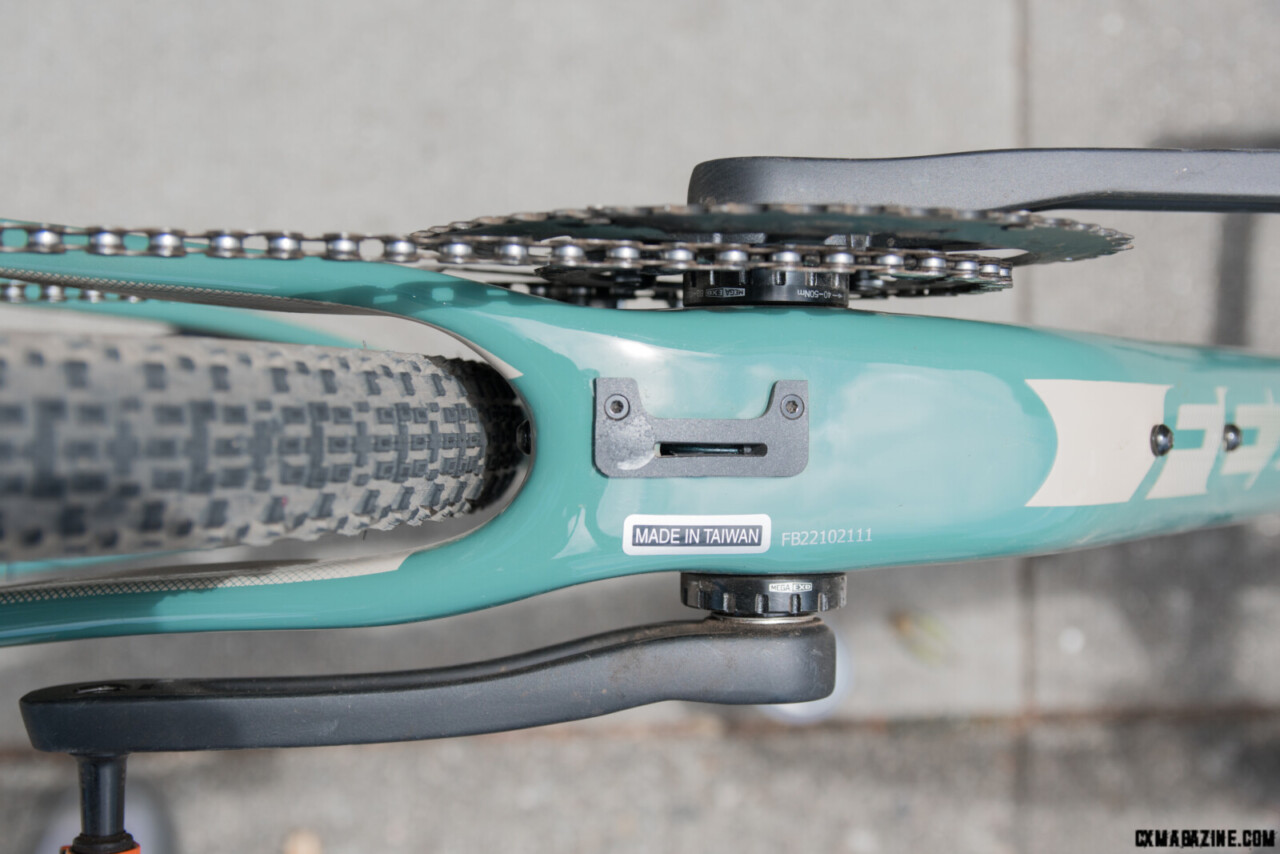
Maximum tire clearance is specified as 50mm. This 45mm Maxxis Rambler fits easily. © C.Lee/ Cyclocross Magazine
The seat stays meet current fashion with a low mount or “dropped” design. A wedge-style clamp secures the seat post, so the top tube junction with the seat tube looks clean following the esthetic of the control line entry. The seat tube narrows below the seat stays to incorporate a wheel contour. The narrowing is a limit for seatpost insertion depth. This is not a real problem if the bike is the correct size for the rider, and not a problem for a dropper post either, since the sloping top tube leaves an ample amount of the seat post exposed. Having a tube of that small diameter at the bottom bracket junction requires thicker walls to maintain tube strength. Tapping on that end of the seat tube indicates high material density—admittedly not a scientific test.
The Fezzari Shafer has 25 threaded mounts, called barnacles by some of us, on the frame that includes 4 bottle mounts, fork cage mounts, rack and fender provisions. With that many steel cap-head machine screws at 2.8 grams each, the resultant 70 grams is over an eighth of a pound in weight alone. Fezzari claims the frame weight for the Shafer is 1160 grams including the derailleur hanger, seatpost wedge and paint. The frame is size M for that weight. All the screws are not included in that specification.
Shimano GRX 400 10-Speed
We have the USD 2300 Sage Green Shafer Comp GRx. This is the entry-level carbon Shafer. As the name indicates, this model has Shimano GRX components, but for that price with a carbon frame, an FSA Omega modular double crankset substitutes for the GRx FC RX600 (there is no GRX 400 equivalent crankset). Although the FSA crank has the Omega label, it is the CK AGX+ Gossamer Pro MExo DM in the FSA catalog. The FSA megaEXO system has a 19mm steel spindle, so only an FSA external bottom bracket will work. The outer chainring has a cheap-looking plastic shroud to cover the bolt holes where the inner chainring mounts. The FSA crank is road compatible, not spaced 2.5mm outboard like Shimano GRX is.
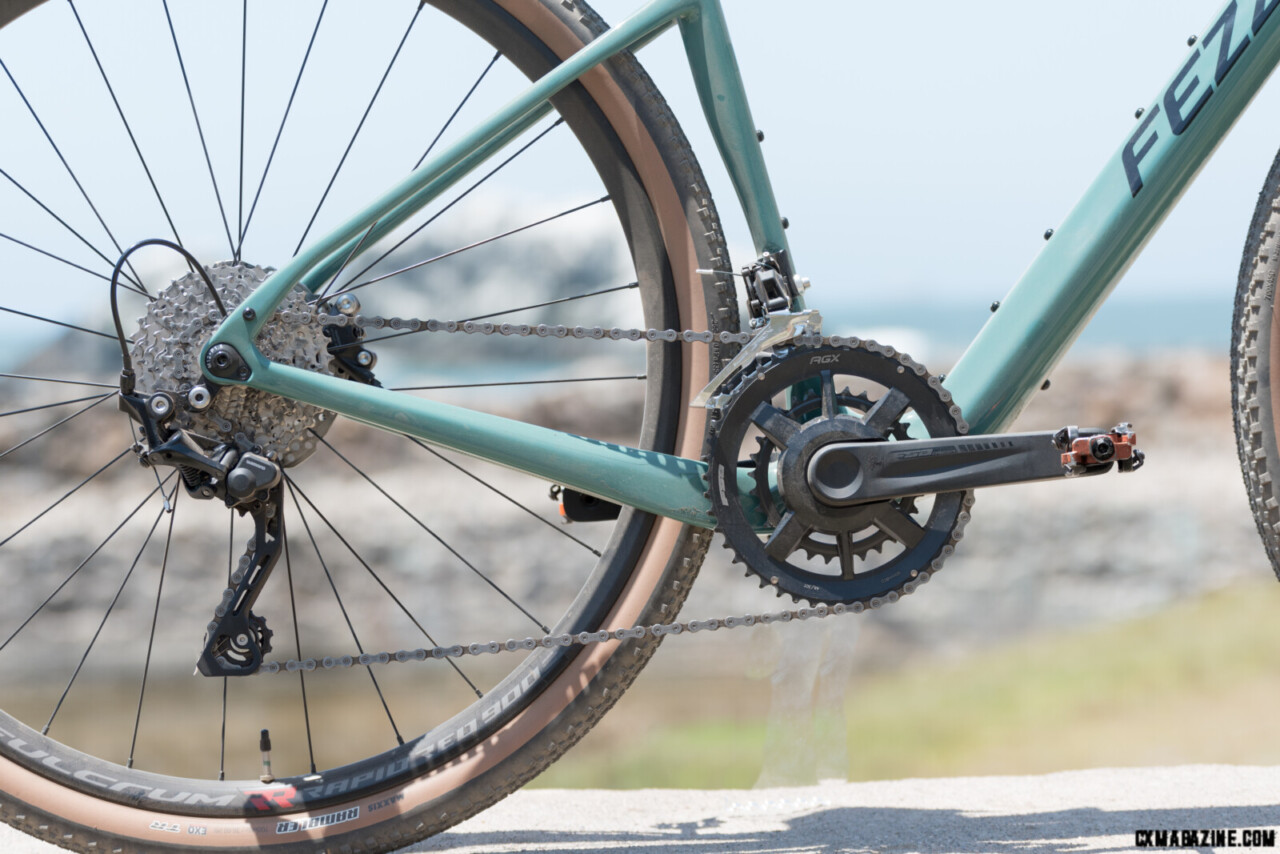
FSA Omega Modular crankset with AGX 48-30 chainrings accompanies the Shimano GRx 400 drivetrain. © C.Lee/ Cyclocross Magazine
Brake/shift levers, front and rear derailleurs, and hydraulic disc brake calipers are Shimano GRX 400. Shimano GRX 400 is 10-speed, but like Tiagra 4700, so it has the same cable pull as 11-speed. That means you pair 11-speed shifters with this derailleur and run 11-speed (along with a change of chain and cassette), or swap in an 11-speed derailleur or Tiagra 4700 “10-speed” rear derailleur and still shift perfectly through your 10 cogs. Any other 10-speed shifter beyond the GRX 400 or Tiagra 4700 won’t work with this derailleur.
A Shimano HG 50 10-speed 11-34 cassette combined with the 48-30 double chainrings yields a 524% range with a 0.83 low ratio or 22.5 gear inches. 160mm Shimano SM RT54 Centerlock rotors are front and rear for resin pads only and are part of the Shimano package.
The Fulcrum Rapid Red 900 is an OEM wheelset from the Campagnolo wheel brand. This is an almost 2000-gram aluminum tubeless-ready wheelset with 22mm internal width rims. 28 stainless straight gauge steel spokes are X2 on the drive side and radial on the non-drive side of the rear wheel. The front wheel is X2 on the rotor side and radial on the opposite side. The wheels have externally accessible brass nipples.
Maxxis 45mm Rambler 60 tpi EXO TR tires are the durable option from Maxxis with this popular gravel tread. The tire is about 600 grams in this configuration with a dense central pattern of low-profile square knobs.
Completing the build is a compliment of Fezzari aluminum components including a 7cm stem with +/- 6 degrees of rise, and a shallow drop (12.5cm) aluminum bar that is 46cm wide at the hoods, flaring to 50cm at the drops. The seat post is carbon with a 2-bolt aluminum clamp on top. The saddle is a Selle Italia model X.
Together, the curb weight with tubes (and no pedals) is 23.0 pounds, and 13.0 pounds without the wheels off. That’s on the upper end of the weight range for a carbon bike, but keep in mind this is one of the more affordable models, and built for adventure, not weight weenies.
Ordering from Fezzari is easy via the website, via a live chat, or even a phone call. You are kept abreast of all phases of your order and the bike arrives in 2-4 weeks. Assembly required is minimal and the drivetrain and brakes are completely adjusted and ready to ride after a bit of brake rotor burn-in. Fezzari has an online support network that includes an assembly video.
Fezzari Shafer Ride
If you ever thought gravel cycling is 1990s mountain biking, this bike embodies that albeit with modern geometry and technology. Compared to a 1991 Specialized Stumpjumper, the Fezzari Shafer is lower by nearly 2cm, and slacker by 8mm of horizontal trail, but with the same low gear, gear spread, and tire width. Think of the terrain ridden by those old, all-rigid mountain bikes; the Fezzari Shafer is comparably versatile.
The Shafer is a bike to use if the course you choose includes steep downhill or technical trails. The Shafer is ready for bike packing and loaded touring given all the mounting points, low center of gravity from the low bottom bracket, and stable front end.
The long-trail steering will come as a demerit on steep climbs, and if the bike is heavily front-loaded. These are theoretical disadvantages and I am not a multiday bike packer, so have limited experience with a front-laden bike. The high trail does create a tendency for the bike to steer to one side or the other (flop) when pointed up. Unloaded, it’s not much different than a modern mountain bike and requires a forward weight shift on the rider’s part to keep the bike on the chosen trajectory on a steep climb. I am only cognizant of this quirk if the pitch is over 15% or so. On a steep technical uphill where you want to change your line to weave through an obstacle, the flop is a demerit. With practice, you learn to overcome this, but still, this is not the bike’s forté.
When the trail points down, the rider’s weight shifts forward and the Shafer geometry positions the rider easily balanced over the low bottom bracket with the front wheel out ahead of, rather than under, the rider. Steering and braking in that scenario feel controlled and confident, similar to the Nukeproof Digger and Chamois Hagar that I took on some very steep downhills. I think a dropper post would be a perfect addition to the Fezzari Shafer based on those experiences. This is the Shafer’s forté.
The 45mm tubeless rubber at close to 20 psi gives a smooth ride, but if the frame has inherent ‘stiffness’ that transmits surface vibration an astute rider will know, adding to fatigue over many miles and time riding the bike. The Shafer does not do that, and even with slightly narrower tires, or with tires pumped up harder, the Shafer seems to have a good damping effect on washboard surfaces like broken pavement, larger gravel, and dirt roads with embedded rocks and roots. The sloped top tube leaves a lot of seatpost exposed. The visible flex of the included Fezzari carbon shaft seatpost contributes to that. I tried an aluminum post. That also flexes, but the feel of the ride certainly changes.
Harder hits on trail features are what usually jar the rider off the chosen line with an adverse effect on handling and confidence. The Shafer is not completely immune to this since there is no active suspension, but the combination of geometry and inherent frame characteristics does a good job for comfort and confidence riding over rough trails including mini rock gardens and small drops.
Horses for Courses
The Shafer is not my choice for a fast cyclocross race. It just feels a bit sluggish during hard acceleration and sprinting, even with a tire and wheel swap that saves over 200 grams. I’m not sure of all the factors that give this feeling since the frame does not “flex” or waver during the sprint, and my weight is over the rear wheel with the reasonably short chain stays. The total bike weight of the Shafer Comp GRX certainly plays a role. The long front center eases unweighting the front wheel in the sand pit and over small obstacles, and it excels on the downhill off-camber. However, it suffers when accelerating out of corners and on ride-ups. Theoretically, the low bottom bracket hinders pedaling through some turns or up an off-camber because of pedal strikes, but I was not affected by this.
Cornering on sweeping turns is very good, but requires minor steering input different from a road bike that only requires a lean. The difference is subtle, but real if you ride the Shafer and a road bike in juxtaposition. The Shafer is reasonable through chicanes if you set up early for entry and get used to turning with your hips, a bit of a technical change compared to a bike with more typical cyclocross geometry. If you are a more advanced mountain bike rider, this is intuitive.
The Shafer is certainly capable for a longer event when you are sitting with your weight on the saddle over the low bottom bracket. The bike wants to stay straight on track as you push along. An event that emphasizes technical agility on downhill sections, such as Grinduro, showcases the Shafer geometry.
All of this said, riders are quite adaptable and these handling nuances are only palpable when you ride different bikes, especially back to back, for comparison. The Fezzari Shafer is not quirky. If it is the only bike you ride, you’d get used to it, ride it, race it, and enjoy it.
Smooth Shifting, but Not Effortless
The performance of Shimano GRx 400 is reliable and accurate-shifting as you might expect. The mechanical cable routing through the headtube combined with the short stem certainly creates cable resistance. I have to put significantly more force into the lever to downshift the rear or upshift the front compared to other GRX bike setups without the tight bends of the headtube cable entry. Other riders also noticed this. The bike has a genuine Shimano-coated shifter cable and the system is new, but I imagine a bit more maintenance is needed to keep this shifting as smoothly as possible through the tight cable bends. Electronic shifting certainly would avoid this problem.
A GRX 400 crankset does not exist, so Fezzari’s choice to save some cost with the spec of the FSA double crankset makes sense. I mentioned the relative chain line position of the road-spaced FSA crank compared to the GRX. The GRX FD Rx400 shifts across the road crank just fine and the chainline is better, especially in the larger cassette cogs than the GRX 2.5mm outboard spacing. As a matter of opinion, I don’t quite know why Shimano just didn’t make GRX 400 11 speed. It uses the same cable-pull ratio as 11 speed with the same RD geometry, so one more cog would not add that much to the cost, but would certainly make compatibility easier.
Lighten Up a Bit
The 1950-gram Fulcrum OEM Rapid Red 900 wheelset works fine and is reliable as a tubeless wheelset, but is quite hefty. Accelerating and steering the heavy hoops is more difficult, compounded by the 600-gram tires. A lighter tire with a better tread in my opinion is the 44mm WTB Raddler. It will save 50 grams per tire, offer a more aggressive cornering tread and still roll well on smoother surfaces. Even then, the hefty wheelset is a good place to upgrade. The Fulcrum hub is Centerlock compatible but has a unique lock ring that threads outside the center-lock flange. This is Campagnolo’s stab at Shimano’s Centerlock standard. The proprietary lock ring is only a problem if you somehow lose it and the associated thin friction washer.
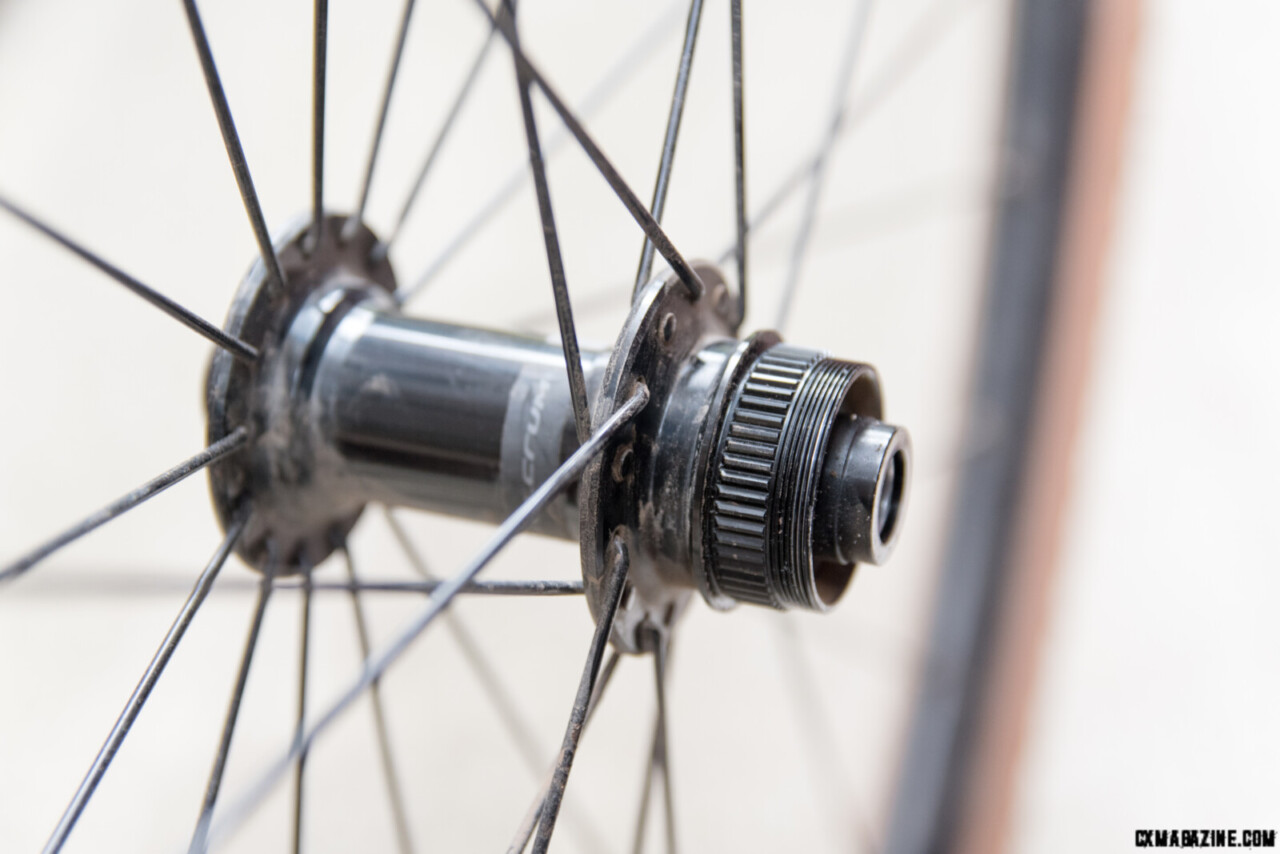
The hub of the Fulcrum Rapid Red 900 has a unique Centerlock lockring compatibility. © C.Lee/ Cyclocross Magazine
Some front wheels with an outer lockring are incompatible with the Fezzari Shafer carbon fork. Like most carbon forks for flat-mount brake calipers, there is a bulge for the lower mounting bracket bolt. It so happens that the bulge position interferes with some wheels with an outside mount lock ring (that uses a bottom bracket tool) for center-lock rotors. Replacement with an inner mount lock ring (that uses a cassette lock ring tool) would solve the problem, but I have a couple of wheels where that lock ring type does not work. I have run across this problem on other bikes before, but very infrequently.
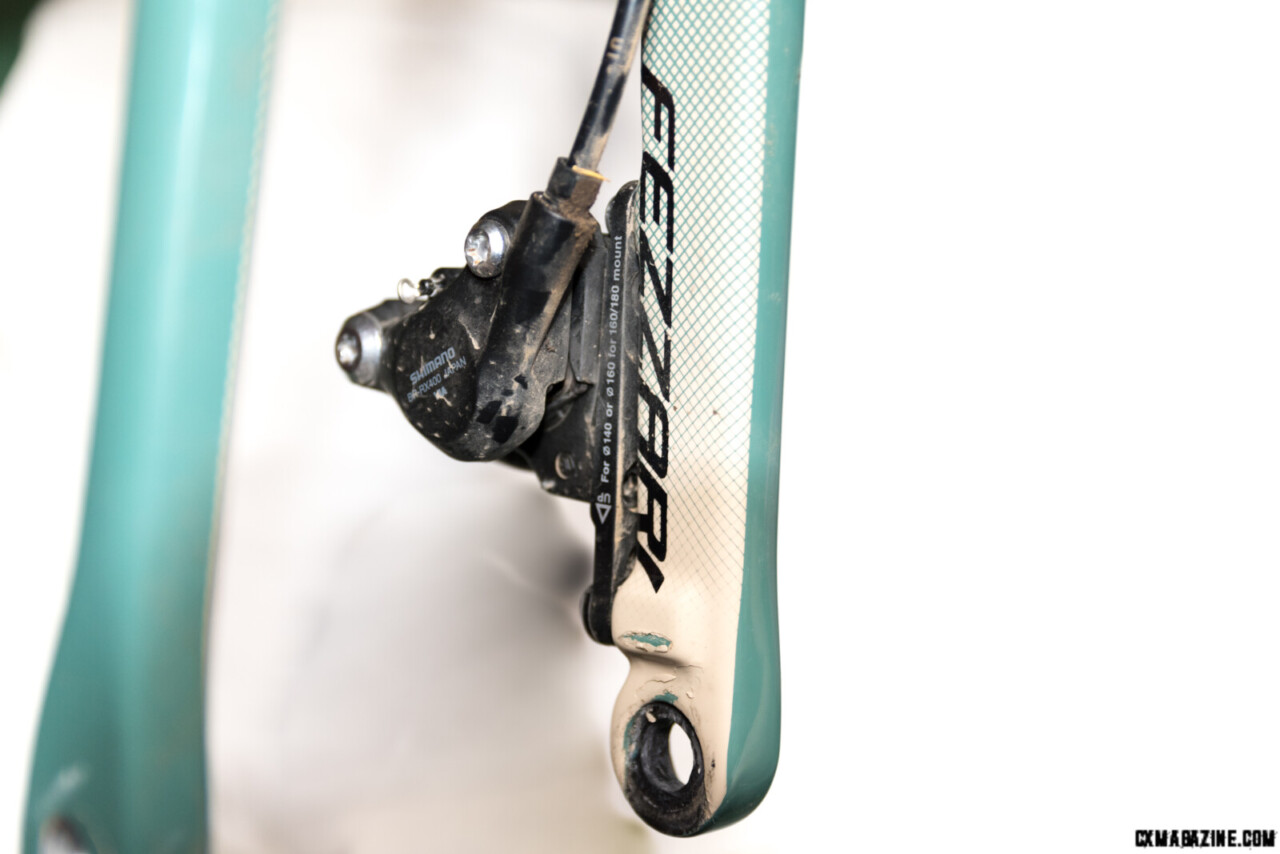
Notice how the bulge of the lower brake mount is scored by the rotor lockring of a non-stock wheel. © C.Lee/ Cyclocross Magazine
I commented on the included Selle Italia Model X saddle in the recent review of the T-Lab X3.22. You cannot deny the green build concept is good, as is the overall saddle shape. The saddle could be improved with a less tacky pad surface. Also, the pad does not overlap with the somewhat sharp edge of the rigid base. If you bump the base, it hurts. The Selle Italia Model X could stand to lose 50-100 grams for its size too. Saddles are a personal choice and a good item to upgrade.
Fezzari Shafer Comp GRX Verdict
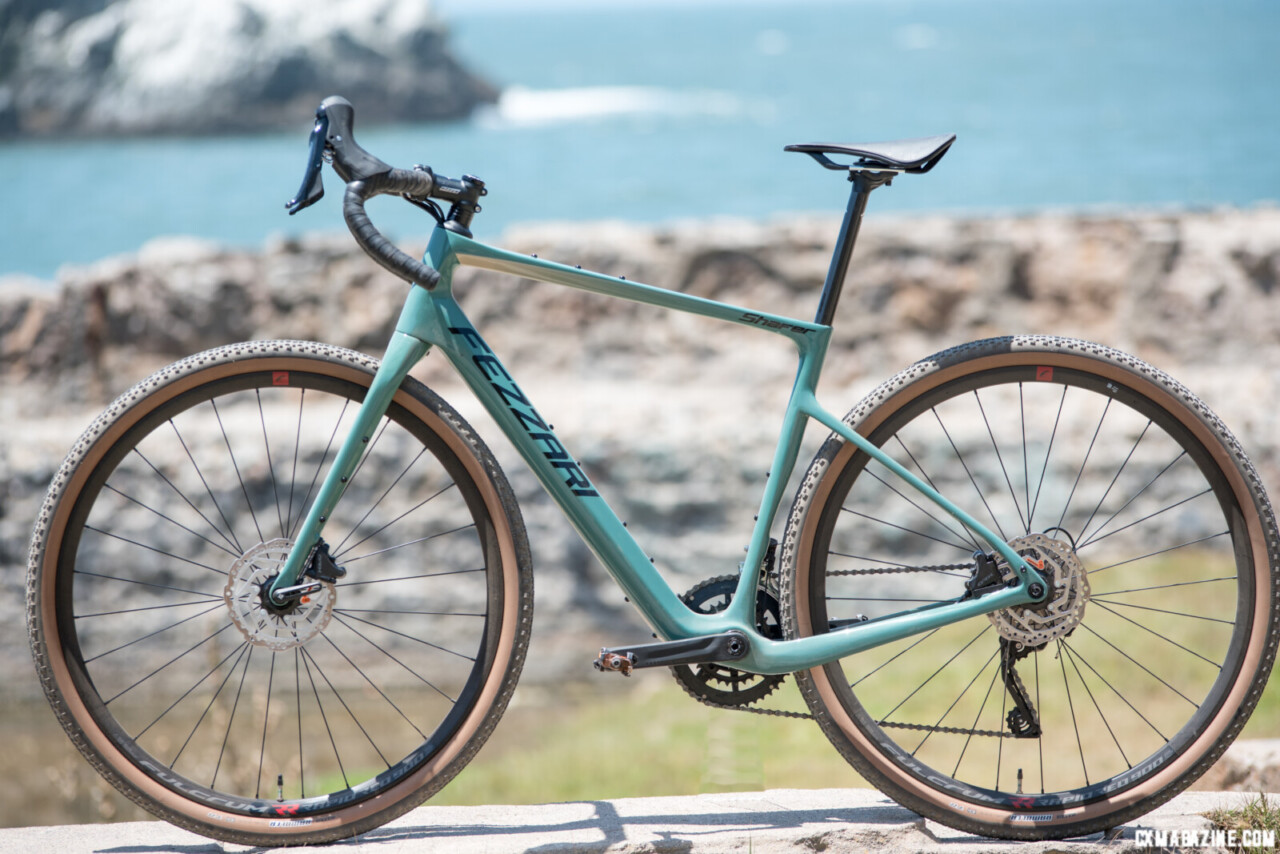
Fezzari Shafer Comp GRX. © C.Lee/ Cyclocross Magazine
If you are looking for a bike that can confidently take you on an adventure where a little less under-biking will increase the fun factor, you cannot go wrong with the Fezzari carbon Shafer Comp GRX with its low entry price of USD 2300. The bike is made-to-order for you and shipped to your door with minimal assembly required. If you can spare another $1000, upgrade the wheelset to the Zipp 303 during your order, or buy an after-market wheelset like the Lōgōs Epoché that is lightweight and a great value. I can verify that those wheels are compatible with the inner mount lock ring, removing any conflict with the Fezzari Shafer carbon fork.
Another upgrade for a bike like the Shafer would be a dropper post. I think it would add to the already confident downhill capability of the Shafer. This option is available with other build kits from Fezzari, with appropriate cost increases. If you are an accomplished bike mechanic and have a load of parts, the Shafer is available as a frameset only for $1700.
You can race the Shafer if you want, but it is not a quick-handling, snappy accelerating bike. It is a stable, steady-hauling bike. That is either head-down hauling it for the long mile, or hauling a load while bike packing!
Fezzari Shafer Comp GRX Bike Specs:
MSRP: $2300 as tested
Frame: Fezzari “Clean Cast” carbon monocoque 12 X 142mm through axle, 68mm BSA BB
Fork: Fezzari “Clean Cast” Carbon Disc, 50mm offset, 2 X 100 through axle
Weight: 23.0 pounds, as tested with no pedals; 13.0 lbs without wheels or pedals
Shifters: Shimano GRX ST Rx400 hydraulic mechanical 10-speed
Crankset: FSA Omega 48-30T double chainring
Brakes: Shimano GRX BR RX400 calipers, Shimano SM RT-54 rotors 160mm front and rear
Cockpit: Fezzari aluminum 7cm stem, 46cm aluminum handlebar
Seatpost: Fezzari carbon with aluminum 2 bolt clamp, 27.2mm diameter
Saddle: Selle Italia Model X, steel rails
Wheels: Fulcrum Rapid Red 900, 22mm inner width aluminum
Tires: Maxxis Rambler 700C X 45mm 60 tpi EXO TL
Warranty: Lifetime against defects in material or workmanship
Country of origin: Taiwan
More Info: fezzari.com













